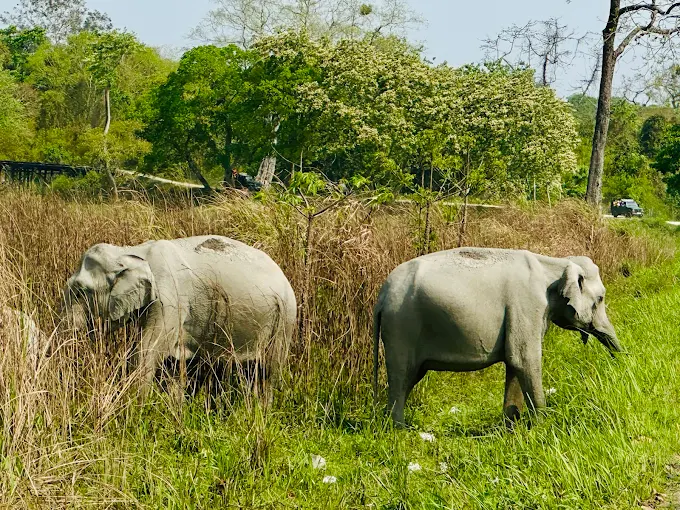
Looking for joy?
Kaziranga National Park
Kaziranga National Park Overview
Kaziranga National Stop is a secured zone in the northeast Indian state of Assam. Spread over the floodplains of the Brahmaputra Stream, its woodlands, wetlands and prairies are domestic to tigers, elephants and the world’s biggest populace of Indian one-horned rhinoceroses. Ganges Waterway dolphins swim in the park’s waters. It’s gone by by numerous uncommon transitory feathered creatures, and gray pelicans perch close Kaziranga village.
Geography: Kaziranga National Stop lies in Assam's floodplains, bordered by the Brahmaputra Stream and the Karbi Anglong Slopes. It highlights tall prairies, swamps, and thick timberlands. The park’s wealthy environment underpins assorted natural life, counting the famous one-horned rhinoceros, making it a basic zone of biodiversity and common beauty.
History: Kaziranga was built up as a save timberland in 1905, taking after preservation endeavors by Mary Curzon. It picked up national stop status in 1974 and got to be a UNESCO World Legacy Location in 1985. Over the decades, it has advanced into a worldwide image of natural life security, particularly for the Indian rhinoceros.
Culture: The locale around Kaziranga reflects Assamese tribal culture, particularly of the Mishing, Karbi, and Bodo communities. Their conventions incorporate people moves, handwoven materials, and nature adore. Neighborhood celebrations and creates grandstand a profound association with the woodland and natural life, mixing legacy with the rhythms of rustic life.
Language: Assamese is the primary dialect talked around Kaziranga, with Hindi and English moreover commonly utilized, particularly in tourism. Nearby tribes communicate in lingos like Mishing, Bodo, and Karbi. Multilingual guides guarantee simple communication for guests investigating the park’s characteristic ponders and adjacent social experiences.
Tourism: Kaziranga draws worldwide sightseers for jeep and elephant safaris to see rhinos, tigers, elephants, and wild buffalo. Birdwatching, nature strolls, and social town visits improve the encounter. Open from November to April, the stop offers an exceptional experience in the midst of crude nature and preservation victory stories.
Transportation: Kaziranga is open through street from Guwahati, Jorhat, and Tezpur. Closest air terminals are in Jorhat and Guwahati, whereas Furkating is the closest railroad station. Taxis, buses, and private vehicles give normal network. Well-maintained interstates make it simple for travelers to reach this wild sanctuary.
Cuisine: Kaziranga’s cooking reflects Assamese flavors—simple, new, and natural. Guests appreciate rice, angle curry, bamboo shoot dishes, and tribal specialties like pork with herbs. Neighborhood thalis and conventional desserts such as pitha are well known. Eco-resorts and lodges serve both bona fide Assamese dinners and recognizable Indian dishes.
Why Travel with "Your India Travel": Traveling with Your India Travel submerges you in Kaziranga’s wild and wondrous rhythm—where the brilliant meadows influence to the trumpets of elephants and the antiquated arrive echoes with the footfalls of the one-horned rhino. We clergyman personalized odysseys through dim wetlands, untamed timberlands, and tribal heartlands. Our master guides reveal the magnificence of Kaziranga’s Huge Five, the avian expressive dance over shining wetlands, and the profound legacy of Mishing and Karbi societies. With smooth transport, handpicked eco-lodges, and keen points of interest, each minute gets to be consistent, enhancing, and exceptional. Find Kaziranga—raw, superb, and untamed—with Your India Travel, where wild, convention, and tastefulness move as one.
.jpg)
Best of East
Assam, Kaziranga National Park
| Hotel B Continental | New Delhi | |
|---|---|---|
| Hotel Rajmahal | Assam | |
| Hotel Lemon Tree | New Delhi | |
|---|---|---|
| Hotel Gateway Grandeur | Assam | |
| The Taj Mahal Hotel | New Delhi | |
|---|---|---|
| Vivanta Guwahati | Assam | |



.webp)


.webp)
.webp)
.webp)
.webp)
.webp)
.webp)
.webp)